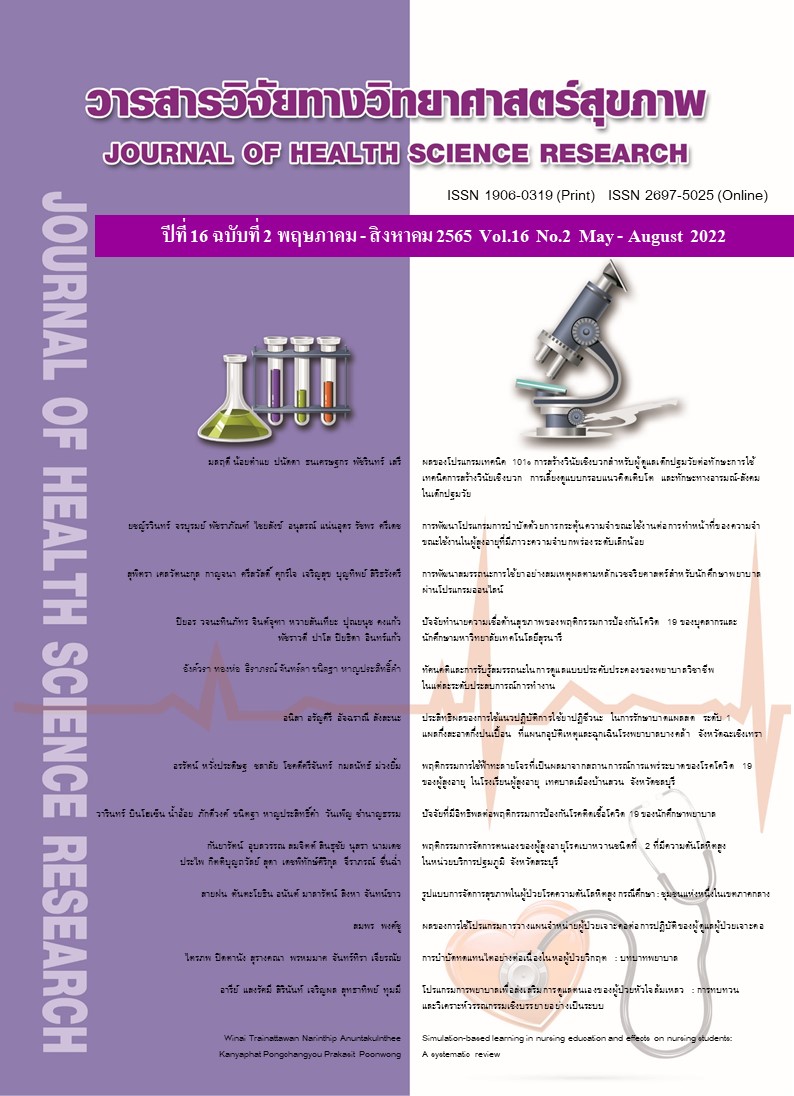การบำบัดทดแทนไตอย่างต่อเนื่องในหอผู้ป่วยวิกฤต : บทบาทพยาบาล
Main Article Content
บทคัดย่อ
การเกิดภาวะไตวายเฉียบพลัน (Acute kidney injury [AKI]) เป็นภาวะที่ไตทำงานผิดปกติ พบได้ในผู้ป่วยที่เข้ารับการรักษาในหอผู้ป่วยวิกฤต หากไม่ได้รับการดูแลอย่างทันท่วงที อาจเกิดภาวะแทรกซ้อนที่รุนแรงหรือทำให้เสียชีวิตได้ การใช้เครื่องบำบัดทดแทนไตอย่างต่อเนื่อง (Continuous renal replacement therapy; CRRT) เป็นหนึ่งในวิธีการบำบัดรักษาสำหรับผู้ป่วยวิกฤตที่มีภาวะ AKI เป้าหมายของการบำบัดด้วย CRRT คือ ทดแทนไตการทำงานที่สูญเสียไปในผู้ป่วย AKI ที่มีระบบไหลเวียนโลหิตไม่คงที่ ผู้ป่วยที่ได้รับสารน้ำและ/หรือส่วนประกอบของเลือดและ/หรือสารอาหารทางหลอดเลือดดำปริมาณมากและไม่สามารถขับออกด้วยยาหรือการฟอกเลือดปกติ การเผาผลาญผิดปกติ ในเลือดมีความเป็นกรดสูงที่เกิดต่อเนื่อง การรักษาด้วย CRRT มีความเสี่ยงสูงและเกิดภาวะแทรกซ้อนที่รุนแรง พยาบาลวิกฤตเป็นหนึ่งในทีมดูแลผู้ป่วยที่ใช้ CRRT มีบทบาทในการดูแลติดตามและป้องกันภาวะแทรกซ้อนที่จะเกิดขึ้นกับผู้ป่วย บทความนี้มีวัตถุประสงค์เพื่อนำเสนอความรู้เกี่ยวกับการพยาบาลผู้ป่วยที่ได้รับการบำบัดด้วย CRRT ผู้เขียนได้รวบรวมข้อมูลเชิงประจักษ์ใน 6 ประเด็น ได้แก่ 1) กลไกการขจัดของเสียของเครื่อง CRRT 2) รูปแบบของการบำบัดด้วย CRRT 3) ข้อบ่งชี้ในการเลือกการบำบัดด้วย CRRT 4) วงจรของระบบ CRRT 5) สารต้านการแข็งตัวของเลือดระหว่างการทำ CRRT และ 6) กรณีตัวอย่างในการพยาบาลผู้ป่วย AKI ที่ได้รับการบำบัดด้วย CRRT บทความนี้จะช่วยให้พยาบาลวิกฤตมีความรู้และความเข้าใจในหลักการทำงานของ CRRT ตลอดจนสามารถประยุกต์ใช้ความรู้ในการดูแลผู้ป่วย AKI ที่ได้รับการบำบัดทดแทนไตด้วย CRRT ได้อย่างมีประสิทธิภาพ
Downloads
Article Details

อนุญาตภายใต้เงื่อนไข Creative Commons Attribution-NonCommercial-NoDerivatives 4.0 International License.
บทความที่ได้รับการตีพิมพ์เป็นลิขสิทธิ์ของวิทยาลัยพยาบาลบรมราชชนนี จังหวัดนนทบุรี
ข้อความที่ปรากฏในบทความแต่ละเรื่องในวารสารวิชาการเล่มนี้เป็นความคิดเห็นส่วนตัวของผู้เขียนแต่ละท่านไม่เกี่ยวข้องกับวิทยาลัยพยาบาลบรมราชชนนี จังหวัดนนทบุรี และคณาจารย์ท่านอื่น ในวิทยาลัยฯ แต่อย่างใด ความรับผิดชอบองค์ประกอบทั้งหมดของบทความแต่ละเรื่องเป็นของผู้เขียนแต่ละท่าน หากมีความผิดพลาดใด ๆ ผู้เขียนแต่ละท่านจะรับผิดชอบบทความของตนเองแต่ผู้เดียว
เอกสารอ้างอิง
Srisawat N, Tungsanga K. Acute kidney injury. Journal of the Department of Medical Services. 2017;42(6):64-8. (in Thai).
Siricheepchaiyan W. Incidence and etiology of acute kidney injury in hospitalized patients in department of medicine, Pranangklao hospital. Journal of Department of Health Service Support. 2021;17(2):51-60. (in Thai).
Yutintorn K, Jearnsujitwimol O. Mortality rate of septic and non-septic acute kidney injury patients requiring hemodialysis in ICU of Prapokklao hospital, Chanthaburi. The Journal of Prapokklao Hospital Clinical Medical Education Center. 2020;37(2): 115-24. (in Thai).
Hinkaew B. Nursing care of acute kidney disease: A case study. Thai Red Cross Nursing Journal. 2016;9(1):46-62. (in Thai).
Fayad AlI, Buamscha DG, Ciapponi A. Timing of renal replacement therapy initiation for acute kidney injury. Cochrane Database Syst Rev. 2018;12(12):CD010612. doi: 10.1002/14651858.CD010612.pub2.
Brain M, Winson E, Roodenburg O, McNeil J. Non anti-coagulant factors associated with filter life in continuous renal replacement therapy (CRRT): a systematic review and meta-analysis. BMC Nephrol. 2017;18(1):69. doi: 10.1186/s12882-017-0445-5.
Balouchi A, Parvizy S, Sharif Nia H. Ebadi A. Dialysis Adequacy among Haemodialysis Patients in Eastern Mediterranean Region: A Systematic Review and Meta-Analysis. Asia Pac. J. Health Manag. 2021;16(4):96-115. doi: 10.24083/apjhm.v16i4.1139
Cerda J, Ronco C. Modalities of continuous renal replacement therapy: technical and clinical considerations. Semin Dial. 2009;22(2):114-22. doi: 10.1111/j.1525-139X.2008.00549.x.
Srisawat N, Pirapornrattana S, Thiranathanakul K, Praditpornsilpa K, Tungsanga K, Eamong S. Textbook of CRRT. 1st ed. Bangkok: Text and general publication; 2018. (in Thai).
Pan HC, Chen YY, Tsai IJ, Shiao CC, Huang TM, Chan CK, et al. Accelerated versus standard initiation of renal replacement therapy for critically ill patients with acute kidney injury: a systematic review and meta-analysis of RCT studies. Crit Care. 2021; 25(1): 5. doi: 10.1186/s13054-020-03434-z.
The Nephrology Society of Thailand. 2018 Hemodialysis treatment and plasmapheresis guideline for kidney patients [Internet]. 2018 [cite 2021 Oct 19]; Available from: คู่มือการฟอกเลือด_e-book_final.pdf (nephrothai.org). (in Thai).
Lee HJ, Son YJ. Factors associated with in-hospital mortality after continuous renal replacement therapy for critically ill patients: A systematic review and meta-analysis. Int J Environ Res Public Health. 2020;17(23): 8781. doi: 10.3390/ijerph17238781.
Tsujimoto H, Tsujimoto Y, Nakata Y, Fujii T, Takahashi S, Akazawa M, et al. Pharmacological interventions for preventing clotting of extracorporeal circuits during continuous renal replacement therapy. Cochrane Database Syst Rev. 2020;12(12):CD012467. doi: 10.1002/14651858.CD012467.pub3.
Liu C, Mao Z, Kang H, Hu J, Zhou F. Regional citrate versus heparin anticoagulation for continuous renal replacement therapy in critically ill patients: a meta-analysis with trial sequential analysis of randomized controlled trials. Crit Care. 2016;20(1):144. doi: 10.1186/s13054-016-1299-0.
Lumlertkul N, Srisawat N. How to run CRRT without Anticoagulant. Thai Journal of Critical Care Medicine. 2020;28(1):7-9. (in Thai).
Royal Thai Government Gazette. 2020 National drug information [Internet]. 2020 [cite 2021 Nov 20]; Available from: https:// dpf.mod.go.th/pdf/บัญชียาหลักแห่งชาติ พ.ศ.2563.aspx. (in Thai).
Davenport A, Tolwani A. Citrate anticoagulation for continuous renal replacement therapy (CRRT) in patients with acute kidney injury admitted to the intensive care unit. NDT Plus. 2009;2(6):439-47. doi: 10.1093/ ndtplus/sfp136.
Khuenkum B. Development clinical nursing practice guideline for acute kidney injury patients with continuous renal replacement therapy in medical intensive care unit Nakornping hospital, Chiang Mai Province. Journal of Nakornping Hospital. 2020;11(2): 64-86. (in Thai).
Mongkolsittikul W. The nursing care of chronic renal failure patients after hemodialysis: Case study 2 case. Mahasarakham Hospital Journal. 2018; 15(2):164-72. (in Thai).


